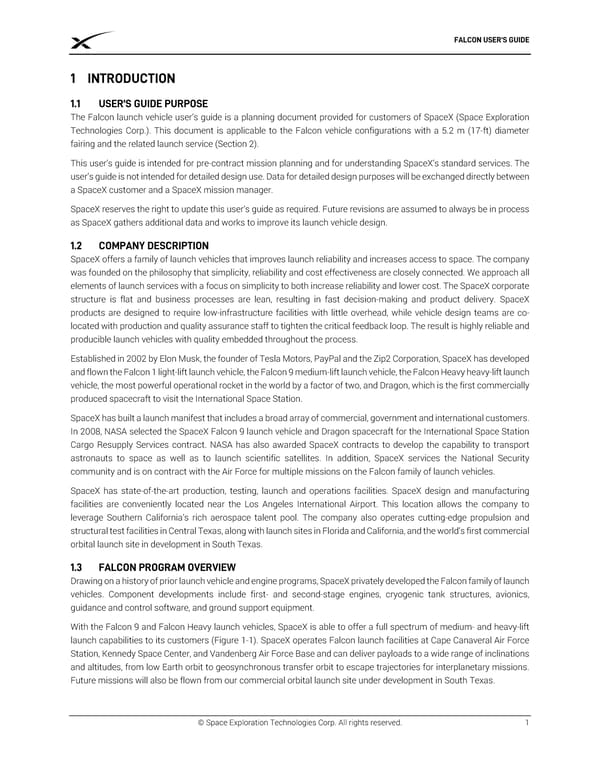FALCON USER’S GUIDE 1 INTRODUCTION 1.1 USER’S GUIDE PURPOSE The Falcon launch vehicle user’s guide is a planning document provided for customers of SpaceX (Space Exploration Technologies Corp.). This document is applicable to the Falcon vehicle configurations with a 5.2 m (17-ft) diameter fairing and the related launch service (Section 2). This user’s guide is intended for pre-contract mission planning and for understanding SpaceX’s standard services. The user’s guide is not intended for detailed design use. Data for detailed design purposes will be exchanged directly between a SpaceX customer and a SpaceX mission manager. SpaceX reserves the right to update this user’s guide as required. Future revisions are assumed to always be in process as SpaceX gathers additional data and works to improve its launch vehicle design. 1.2 COMPANY DESCRIPTION SpaceX offers a family of launch vehicles that improves launch reliability and increases access to space. The company was founded on the philosophy that simplicity, reliability and cost effectiveness are closely connected. We approach all elements of launch services with a focus on simplicity to both increase reliability and lower cost. The SpaceX corporate structure is flat and business processes are lean, resulting in fast decision-making and product delivery. SpaceX products are designed to require low-infrastructure facilities with little overhead, while vehicle design teams are co- located with production and quality assurance staff to tighten the critical feedback loop. The result is highly reliable and producible launch vehicles with quality embedded throughout the process. Established in 2002 by Elon Musk, the founder of Tesla Motors, PayPal and the Zip2 Corporation, SpaceX has developed and flown the Falcon 1 light-lift launch vehicle, the Falcon 9 medium-lift launch vehicle, the Falcon Heavy heavy-lift launch vehicle, the most powerful operational rocket in the world by a factor of two, and Dragon, which is the first commercially produced spacecraft to visit the International Space Station. SpaceX has built a launch manifest that includes a broad array of commercial, government and international customers. In 2008, NASA selected the SpaceX Falcon 9 launch vehicle and Dragon spacecraft for the International Space Station Cargo Resupply Services contract. NASA has also awarded SpaceX contracts to develop the capability to transport astronauts to space as well as to launch scientific satellites. In addition, SpaceX services the National Security community and is on contract with the Air Force for multiple missions on the Falcon family of launch vehicles. SpaceX has state-of-the-art production, testing, launch and operations facilities. SpaceX design and manufacturing facilities are conveniently located near the Los Angeles International Airport. This location allows the company to leverage Southern California’s rich aerospace talent pool. The company also operates cutting-edge propulsion and structural test facilities in Central Texas, along with launch sites in Florida and California, and the world’s first commercial orbital launch site in development in South Texas. 1.3 FALCON PROGRAM OVERVIEW Drawing on a history of prior launch vehicle and engine programs, SpaceX privately developed the Falcon family of launch vehicles. Component developments include first- and second-stage engines, cryogenic tank structures, avionics, guidance and control software, and ground support equipment. With the Falcon 9 and Falcon Heavy launch vehicles, SpaceX is able to offer a full spectrum of medium- and heavy-lift launch capabilities to its customers (Figure 1-1). SpaceX operates Falcon launch facilities at Cape Canaveral Air Force Station, Kennedy Space Center, and Vandenberg Air Force Base and can deliver payloads to a wide range of inclinations and altitudes, from low Earth orbit to geosynchronous transfer orbit to escape trajectories for interplanetary missions. Future missions will also be flown from our commercial orbital launch site under development in South Texas. © Space Exploration Technologies Corp. All rights reserved. 1
 SPACEX FALCON USER’S GUIDE Page 4 Page 6
SPACEX FALCON USER’S GUIDE Page 4 Page 6